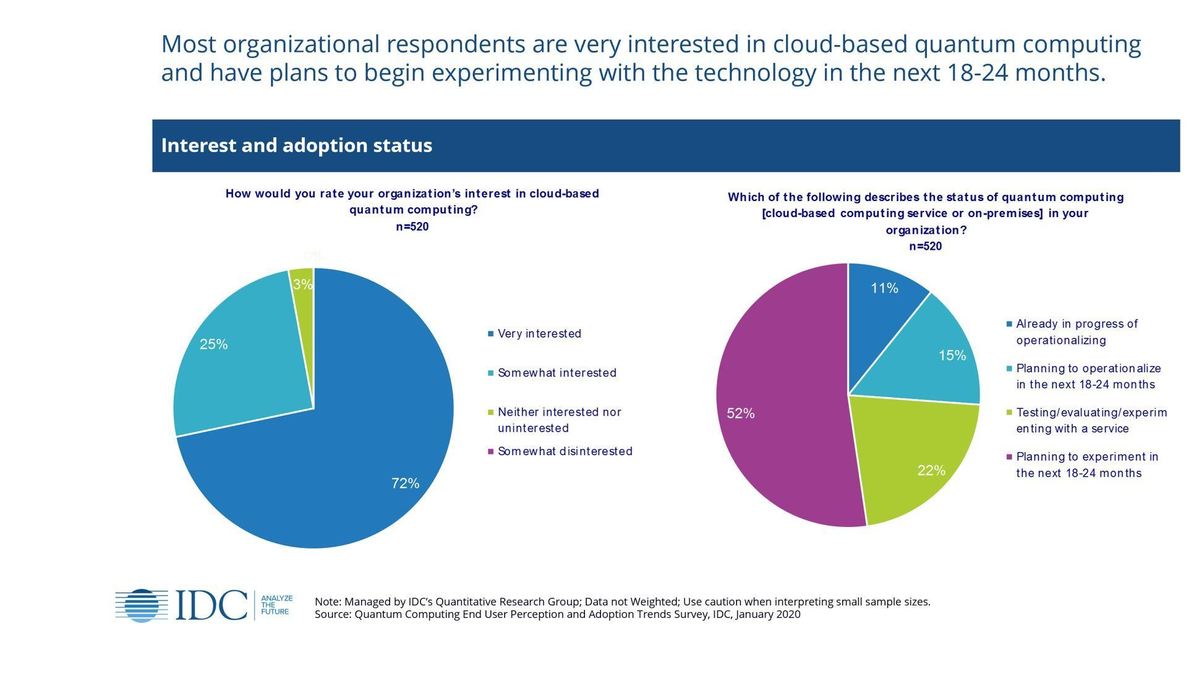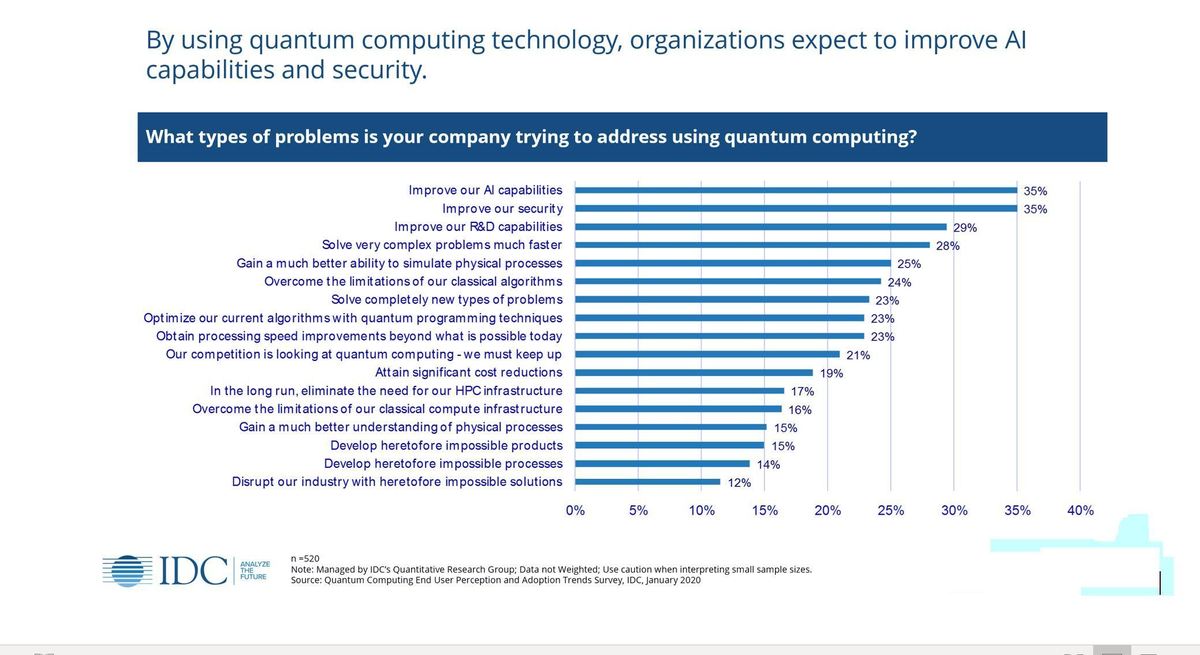advertisement
Is Quantum Computing Ready to Leap into The Real World?
Market research firm IDC predicts that by 2023, 25% of Fortune 500 companies will gain a competitive advantage from quantum…

Market research firm IDC predicts that by 2023, 25% of Fortune 500 companies will gain a competitive advantage from quantum computing.
It’s a bold prediction given the current dearth of real-world examples of quantum computing in action. However, there’s plenty of industry activity to back up IDC’s forecast. In fact, early this year at the Consumer Electronics Show the biggest buzz wasn’t the newest smartphone, wearable device or autonomous-driving technology, but rather unprecedented computing power based on an area of quantum physics Albert Einstein described as “spooky action at a distance.”
While quantum computing hasn’t yet factored into solving worldwide problems such as the coronavirus pandemic, that is exactly the type of problem quantum has the potential to address. That potential will turn into a reality, according IBM, one of a handful of tech giants leading the quantum charge. “This is the decade that quantum computing gets real,” says Katie Pizzolato, director at IBM QStart.
advertisement
For that reason, Pizzolato said, it was important to keep quantum public-facing rather than keep it a technology buried in research facilities. “We wanted to get quantum out of the labs and into the real world,” she said in reference to IBM’s strong presence at CES.
Companies such as Google, Microsoft, D-Wave and Regetti are also eager to move quantum forward, and based on IDC’s recent report “Quantum Computing Adoption Trends: 2020 Survey Findings”, the technology is building momentum.
According to responses from 520 IT and line-of-business professionals, quantum computing budgets and implementations will increase in the next 18-24 months. Half of all respondents to the IDC survey reported that funds allocated for quantum computing accounted for just 0-2% of the annual IT infrastructure in 2019, but will account for 7-10% in the next 24 months. For companies with more than 10,000 employees, the spending increase is more dramatic – more than half of respondents will spend between 9% and 14% on quantum technology over the next two years.
advertisement
Respondents to the IDC survey were clear where they are focusing their attention: 65% of respondents are using to plan to use cloud-based quantum computing, followed by 45% who use or plan to use quantum algorithms (which includes simulators, optimizations, artificial intelligence, machine learning and deep learning). Quantum networks (44%), hybrid quantum computing (40%) and quantum cryptography (33%) round the top five, according to the IDC survey.
 IDC
IDCWhy companies want quantum computing
Heather West, IDC senior research analyst, Infrastructure Systems, Platforms and Technology and one of the report’s authors, says that quantum computing excels at solving large problems where there’s so much data. The initial areas of focus will be AI, business intelligence and overall productivity and efficiency, according to the IDC report.
“Very few companies have actually operationalized [quantum computing]. The skillsets are so advanced, and few people really understand quantum,” West said, adding that we’re still at the experimentation stage with algorithms as companies also look to overcome challenges such as cost, security and data transfers between vendors. West points out, however, that there are already practical use cases in areas such as manufacturing and finance.
advertisement
Right now, West says, the focus is on how to optimize processes. However, in the future, quantum will be applied to larger problems such as “how to address climate change and cure diseases.”
 IDC
IDCAs IDCs West says, quantum computing isn’t without its challenges. IDC cites complex technology, skillset limitations, a lack of available resources, cost, security, data transfer among vendors as barriers to adoption. With so many challenges, it’s not surprising that when selecting vendors to support quantum technology initiatives big names dominate the responses in the IDC survey. Google tops the list with 37% of respondents citing it as the vendor of choice, followed by Microsoft with 32%, IBM with 27% and Intel with 23&.
Understanding quantum computing
What makes quantum computing more powerful than classical computing is that rather relying on binary bits (i.e, either a 1 or 0) quantum computing uses qubits. Qubits can process more data because they can exist in many possible combinations of 1 and 0 simultaneously, known as superposition, processing an enormous number of outcomes.
In addition to superposition, pairs of qubits can be “entangled.” This entanglement is what makes quantum computers as powerful as they are. What make it even more intriguing is that no one knows how – or why – it works, prompting that “spooky action” description from Einstein.
In classical computing, doubling the amount of bits gives you, as you’d expect, twice the computing power. However, thanks to entanglement adding more qubits gives you exponentially more processing power.
If processing power potential is the good news on qubits, their fragile nature is the bad news. “Not all qubits are created equal,” IBM’s Pizzolato says. Qubits are unpredictable and susceptible to environmental noise and errors. After an error they fall back to a binary state of 1 or 0, so the longer the calculation runs without an error, the greater the calculation. The goal is to “protect against errors” to solve the most challenging problems, Pizzolato says.
How common are these errors? A slight fluctuation in temperature or vibration can cause what’s known as “decoherence.” And, once a qubit is in decoherence, its calculation has failed and must be run again. For that reason, quantum computers are housed in environments of near absolute zero and with little outside disruption.
More qubits help. “The 50 qubits range is when you start to supersede what you can achieve on a supercomputer,” says Pizzolato. IBM last fall announced its 14th quantum computer, a 53-qubit system. Its previous quantum computers were 20 qubits. However, quantum is more than qubits. “Hardware is at the center of the circle, but then you have the algorithms and the applications,” says Pizzolato. More sophisticated algorithms are critical to quantum computing’s real-world success. “Quantum is all about the algorithms you can run and the complexity of those algorithms,” she says.
Quantum development
Skills gaps are a challenge for IT in general. With quantum computing, it’s magnified. Where will the quantum development come from? Peter Rutten, research director and one of the authors of the IDC report, says that the algorithms and application development will come from three distinct personas:
Developers who are intrigued with quantum computing, developers with a physics background (because there are not many jobs in physics) and those working in high-performance-computing operations. “It’s a seamless transition from HPC algorithms to quantum,” Rutten says.
On the one hand, Google, IBM and others appear to be jostling for position in achieving quantum advantage (the point at which quantum computing can solve a program faster than classical computing) and quantum supremacy (when quantum computing solves a program that no conventional computer can solve). In fact, IBM recently publicly refuted Google’s claim of achieving quantum supremacy with its 53-qubit computer, its researchers saying that Google failed to fully estimate the resources of a supercomputer, publishing this in an IBM Research blog last October:
“Building quantum systems is a feat of science and engineering, and benchmarking them is a formidable challenge,” according to an IBM quantum-computing blog. “Google’s experiment is an excellent demonstration of the progress in superconducting-based quantum computing, showing state-of-the-art gate fidelities on a 53-qubit device, but it should not be viewed as proof that quantum computers are “supreme” over classical computers.”
On the other hand, despite the top-tier vendors seemingly jockeying for quantum positions, IDG’s Rutten said, it’s not about competitors going head-to-head. “It’s hard to compare. No one can tell you [who’s ahead] because they are measuring progress in different ways,” he says. “The notion of quantum being a race is silly.”
IDC’s West concurs, saying that quantum advances will come from the developer community and technology partnerships. “It’s not so much a race to the end, because there may not be just one answer.”
For its part, IBM has a network of 100 partnerships from commercial (e.g, Goldman Sachs, ExxonMobile, Accenture and others), academic (e.g., MIT, Virginia Tech, Johns Hopkins and dozens of others), startups, government and research sectors.
Even with the likes of Google, IBM and Microsoft pushing quantum computing to go from advantage to supremacy, no one knows where the big innovation will come from, Pizzolato says. “The MVP is probably a guy in a lab.”